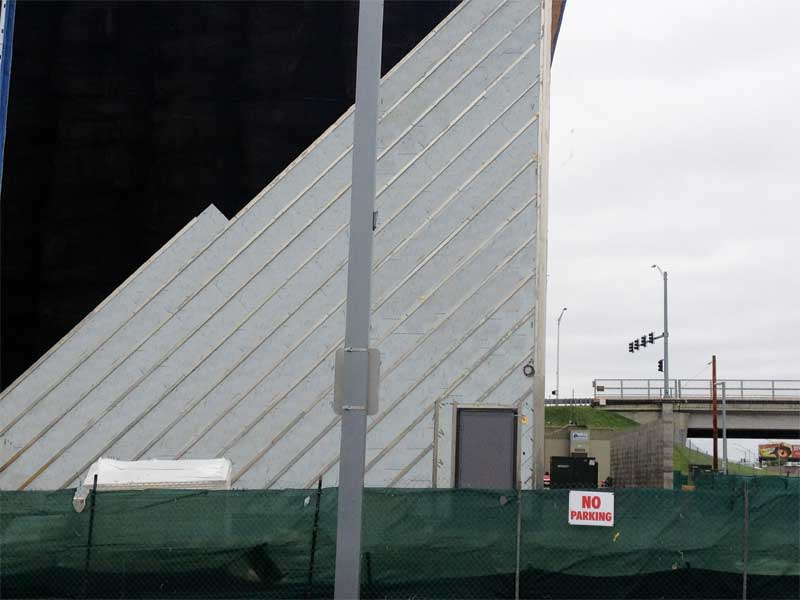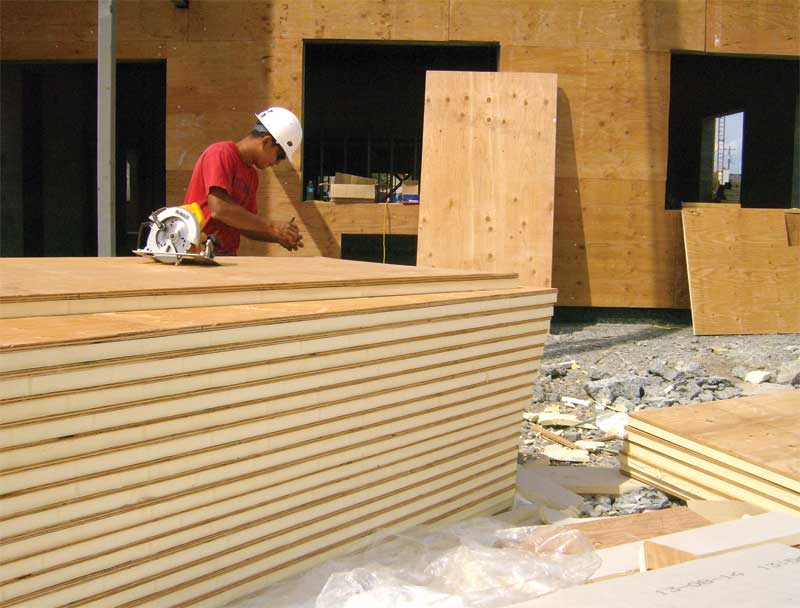
Insulation for various wall assemblies
Although no single insulation type or brand is ideal for all wall applications, the following factors must be considered when specifying polyiso, EPS, and XPS in NFPA 285-compliant assemblies.
Polyiso
Insulation manufacturers have developed many different polyiso product options (e.g. multiple facers and composite panels) that have passed NFPA 285 testing within steel-frame, concrete masonry unit (CMU), and concrete wall assemblies, with a wide range of cladding types and weather barriers. Polyiso offers the highest R-value per inch of the rigid foams, so it can help create thinner-profile, NFPA 285-compliant wall assemblies than XPS. One product option is polyiso laminated to fire-treated plywood, which helps simplify exterior cladding installation by providing the full panel surface as an attachment point instead of using Z-girts, clips, or rail systems.
EPS and XPS
As with polyiso, the polystyrene-based insulations are available in a range of product compositions. Both EPS and XPS products are available for NFPA 285-compliant assemblies using steel studs, CMU, and concrete. However, there can be limitations on cladding, and special fire-protection detailing might be required. For example, window and door header details are crucial to NFPA 285 compliance, and some materials, such as XPS, may require complex fire-protective details like a steel angle and mineral wool to protect the insulation from flash-over from a fire.

Other continuous insulation options
Beyond the rigid foams, other CI options include:
- sprayed polyurethane foam (SPF);
- mineral wool;
- exterior insulation and finish systems (EIFS);
- insulated claddings; and
- pre-insulated concrete.
As SPF is combustible, like the rigid foams, it is required to pass NFPA 285 within full-assembly testing. Although mineral wool is not combustible, specifying it as CI does not eliminate the need for NFPA 285 compliance, as many other building envelope products commonly combined with mineral wool can trigger NFPA 285. These include water- and weather-resistive barriers (WRBs), which are crucial to the wall’s hygrothermic performance.
Among EIFS, insulated claddings, and pre-insulated concrete products, NFPA 285-compliant wall assemblies are generally limited to specific manufacturers. As most of these are proprietary products, their discussion is beyond the scope of this article, and details should be confirmed with the manufacturer.
Conclusion
The NFPA 285 test is vital for building occupant and fire safety, and is increasingly being applied as CI requirements are adopted into state and local building codes. Without proper documentation of NFPA 285 compliance, jobs might be red-tagged by the building inspector until such documentation is provided, and one or more materials may need to be removed or changed. At the extreme, the building team could be required to undertake a costly and disruptive building envelope redesign. As there is currently no centralized directory of NFPA 285-compliant products, it is important to confirm testing with the insulation manufacturer.
MacGregor Pierce is a product and technical manager for Hunter Panels, a manufacturer of polyisocyanurate (polyiso) insulation products. He has more than 30 years of experience in the construction industry, including work as a general contractor for commercial buildings and directing logistics and product development for Hunter Panels. Pierce is also active with insulation codes and compliances; he is vice chair of the Foam Sheathing Committee and a past chair of Polyiso Insulation Manufacturers Association (PIMA). He can be reached at macgregor.pierce@hpanels.com.





Nice article. I am directing my Building Codes class to read the article. I will be looking for samples of the Polyiso product from the contact information.
Very informative article. I was eager to learn the NFPA285 procedure and I think it’s very interesting how they do it and conclude a final “pass” or “fail”.
Great article. I think having the NFPA 285 decide with pass or fail makes it easier and safer for the users.
This is a greatly informative article, it provided insightful details about the NFPA 285 test. The fire testing process is intriguing as well, it would be cool to see the test live & compare the reactions of the many products that undergo the evaluations.
This article really shows how involved and thorough fire testing can be. This seems like a great test to implement to avoid reinspections and redesigns.
Great read! This article was very helpful in understanding the NFPA 285 test.
Interesting article. It was well written and cut to the chase explaining the testing process and making it easy to understand. Hopefully the results from the testing help to cut down unneccasry casulaties from fires.
It is essential to ensure fire safety in building codes. Too many deaths and property damage occur when safety measures are not followed. It is interesting to know that one aspect of the fire inspection can pass; however, it fails in another aspect concerning material.
It best to use the NFPA 285 so that way it can be use on test and no live will be lost due to weak fire structure.
This article gives excellent detail about the whole NFPA 285 test process. This is an efficient way to prevent costly repairs from fire casualties.
Very informative article. I really enjoyed learning about the NFPA 285 and interesting to see how detailed one must be during fire testing.
The article is great and informative. It summarizes NFPA 285 in a way that is easy to understand and learn.
I’ve been trying to push our lab to run more of these types of tests. Not quite to this extent but similar fire-resistant materials. Great read!
Great article! Very informative regarding the NFPA 285’s fire safety procedures on combustible materials taken to reduce the risk of loss of life and property.
Well-written article. The information provided by NFPA 285 evaluation the performance of combustible and noncombustible materials to provide a safe wall assembly. The details of how they accomplish testing and assure safety are well-organized and laid out. Overall, the article gives a general and meaningful explanation of the main safety measures taken to complete a wall assembly.
A well organized article and i am looking froward to pass this article down to someone because it has a lo of valuable information.
great article without these rules and pass or fail many buildings structures and or projects wouldnt be that safe.
It is essential to ensure fire safety in building codes. Too many deaths and property damage occur when safety measures are not followed. It is interesting to know that one aspect of the fire inspection can pass; however, it fails in another aspect concerning material.
This is a fantastic article. The NFPA 285 ensures the safety of our materials while saving lives.
The information provided in this article was very helpful in learning what the NFPA 285 test is, how it was arrived at, and many more details that help us understand what the NFPA 285 test provides.
Thank you for this information, now I know how the wall assemblies’ performance are tested which is by time.
Very insightful article, I did not know that materials were tested in this way.
Great article, It was very useful for the class quiz on the NFPA 285 test.
Great article, it makes it very easy to understand NFPA 285.
This is an amazing article, has some very good key points. These codes are needed to reduce the risk of any issues later on in the future.
This was a very educational piece. I was extremely excited to understand the NFPA285 process since I find it fascinating how they conduct it, and determine if it is a final “pass” or “fail.” These are great articles and informative.
This article was very informative, it does a great way of explaining the NFPA 285 test and how it is vital for building occupant and fire safety.
The article is informative, and discuss NFPA 285 testing plays a crucial role in ensuring the safety and integrity of modern building designs, particularly those employing exterior wall assemblies with combustible components.
The article is well-written. I appreciate the fact that those beginning to learn about building codes and materials can read the article and easily understand the content. It’s amazing to learn about all the ways that building codes are written in order to provide safety and preserve life.
I appreciate this article because it is an excellent example of the effort being put nowadays into testing for fire safety. Further, I like how the article explains how fire safety and sustainability work hand in hand.
This was an amazing article. This has helped me understand some of the building codes.
This article is so informative and well-written. It was informative about the NFPA 285 and their safety procedures.
i think having regulations for types of insulation and foam insulation is critical. i’ve seen older fluffy style insulation in older homes and i know that it would catch fire and burn like a wildfire.
Very informative information on the NFPA 285 and its purpose in providing safety in the building process.
It’s interesting how this test is performed. I wonder how they came to a decision on the standard procedure of the test.
Very detailed article, interesting the way they conduct temperature tests on these materials.